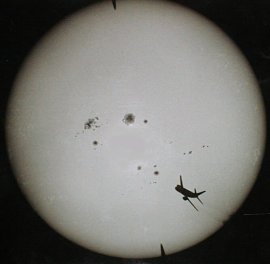Sunspots
Today, we talk about sunspots, China, and Galileo. The University of Houston's College of Engineering presents this series about the machines that make our civilization run, and the people whose ingenuity created them.
In 1605 Father Ricci, a Jesuit in China, wrote the Vatican asking them to send a mathematical astronomer to join him in Peking. He'd found the Chinese very interested in the subject. They'd already soaked up everything he had to offer.
He got his astronomer eight years later. In the meantime, a young Galileo had become famous by making the first Italian telescope and discovering remarkable things with it. The man Rome sent to Peking was a student of Galileo's.
At that time, Galileo's stock was very high in the Catholic church. Some scholars sensed that his work was leading up to the destruction of Ptolemaic astronomy -- which was part of Catholic theology. But the issue of a sun-centered solar system hadn't arisen yet. For the moment Rome was fascinated.
Galileo's first assault on the perfect universe was his discovery of imperfection in the planets. First he'd shown that the moon wasn't sublime empyrean matter at all. It was pitted and scarred rock. Then he'd found that the sun had spots.
Western literature often credits Galileo with discovering sunspots. In fact he was not by any means the first to see them. Islamic scientists had seen them, and so too had earlier Europeans. But sightings in the West were made and forgotten -- they didn't fit the general conviction that the heavens were perfect.
The Chinese had no such illusions about the heavens. They had no problem with imperfect planets. Sunspot observations in China were continuous right back to the fourth century BC. Historian Joseph Needham finds 112 references to sunspots between 28 BC and the death of Galileo, and that was in official histories alone. None of that needed the help of Galileo's telescope, because the Chinese were quite ready to see what they saw.
By the time Galileo had fallen from grace and gone on trial in Rome, his telescope and his ideas had found their way to Japan. The Japanese put a telescope in Nagasaki harbor to warn against approaching foreigners. They hadn't much cared about the heliocentric universe before, but now they claimed Japanese scholars had discovered it. They even claimed the idea was part of their own ancient religious orthodoxy.
And so the great revolution of astronomy began. Galileo's sight was permanently damaged from looking at sunspots through his telescope. Controversy flared among the Jesuits. Revisionist history sprang up in Japan. And the practical Chinese took up the telescope to direct field artillery.
I'm John Lienhard, at the University of Houston, where we're interested in the way inventive minds work.
(Theme music)
Boorstin, D.J., The Discoverers. New York: Random House, 1983, pp. 332-336.
Temple, R., The Genius of China. New York: Simon & Schuster, 1986, pp. 28-30.
For an excellent web site on sunspots, see: http://www.spaceweather.com/java/sunspot.html

(Photo courtesy of the Astronomy Department, UCLA)
A remarkable photo of sunspots taken by UCLA astronomers at the Solar Tower, Mount Wilson Observatory just as an airplane passed across the plane of view